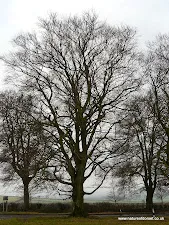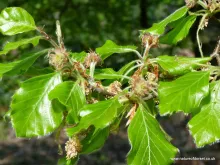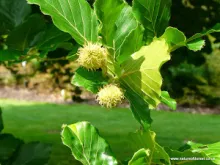In Depth
| Beech |
|---|
Title: Beech Tree: Guardian of the Forests, Symbol of Strength and VitalityIn the verdant tapestry of forests worldwide, one tree stands tall as a symbol of resilience, longevity, and natural grandeur—the beech tree (Fagus spp.). Revered for its majestic stature, distinctive foliage, and ecological importance, the beech tree holds a special place in both the natural world and human culture. Botanical Marvel: Belonging to the genus Fagus within the family Fagaceae, the beech tree comprises several species, including the European beech (Fagus sylvatica) and the American beech (Fagus grandifolia). These deciduous trees are renowned for their smooth, silver-gray bark, which develops unique fissures and ridges over time, creating a characteristic visual texture. Characteristics and Habitat: Beech trees typically boast broad, spreading crowns adorned with lush, ovate leaves. In spring, their foliage emerges in vibrant hues of green, casting a refreshing canopy of shade beneath. Come autumn, the leaves transform into a dazzling display of copper, bronze, and golden tones, painting the forest landscape with breathtaking splendor.These majestic trees favor temperate regions across the Northern Hemisphere, thriving in a variety of habitats, including mixed deciduous forests, upland woodlands, and even urban parks. With their adaptability to diverse soil types and climates, beech trees play a vital role in shaping the ecological fabric of their surroundings. Ecological Importance: Beyond their aesthetic appeal, beech trees serve as linchpins of forest ecosystems, providing critical habitat and sustenance for a myriad of flora and fauna. Their dense foliage offers shelter and nesting sites for birds and small mammals, while their abundant mast—beechnuts—serves as a vital food source for wildlife, including deer, squirrels, and various bird species. Moreover, beech trees contribute to soil fertility through their nutrient-rich leaf litter, which decomposes to enrich the forest floor with organic matter. Their extensive root systems help stabilize soil, prevent erosion, and promote water infiltration, thereby mitigating the impacts of flooding and runoff. Cultural Significance: Throughout history, beech trees have held profound cultural significance in many societies, symbolizing wisdom, strength, and longevity. In folklore and mythology, these venerable trees are often associated with protection, knowledge, and the divine. From the ancient Celts, who revered the beech as a sacred tree of wisdom, to modern poets and artists who draw inspiration from its timeless beauty, the beech tree continues to captivate the human imagination. Challenges and Conservation: Despite their resilience, beech trees face numerous threats in the modern world, including deforestation, habitat fragmentation, and the spread of invasive pests and diseases. In recent years, the beech bark disease, caused by a combination of scale insects and fungi, has decimated beech populations across North America, underscoring the urgent need for conservation efforts and proactive management strategies. Appreciating Nature's Guardians: In conclusion, the beech tree stands as a towering sentinel in the forest, its roots anchored deep in the earth, its branches reaching skyward in silent reverence to the cycles of life. As stewards of the natural world, it is incumbent upon us to safeguard these ancient giants, preserving their legacy for future generations to cherish and admire. For in the timeless embrace of the beech tree, we find solace, inspiration, and a profound connection to the living tapestry of life. |



